climate control PONTIAC GRAND-PRIX 1993 Owners Manual
[x] Cancel search | Manufacturer: PONTIAC, Model Year: 1993, Model line: GRAND-PRIX, Model: PONTIAC GRAND-PRIX 1993Pages: 338, PDF Size: 17.3 MB
Page 94 of 338
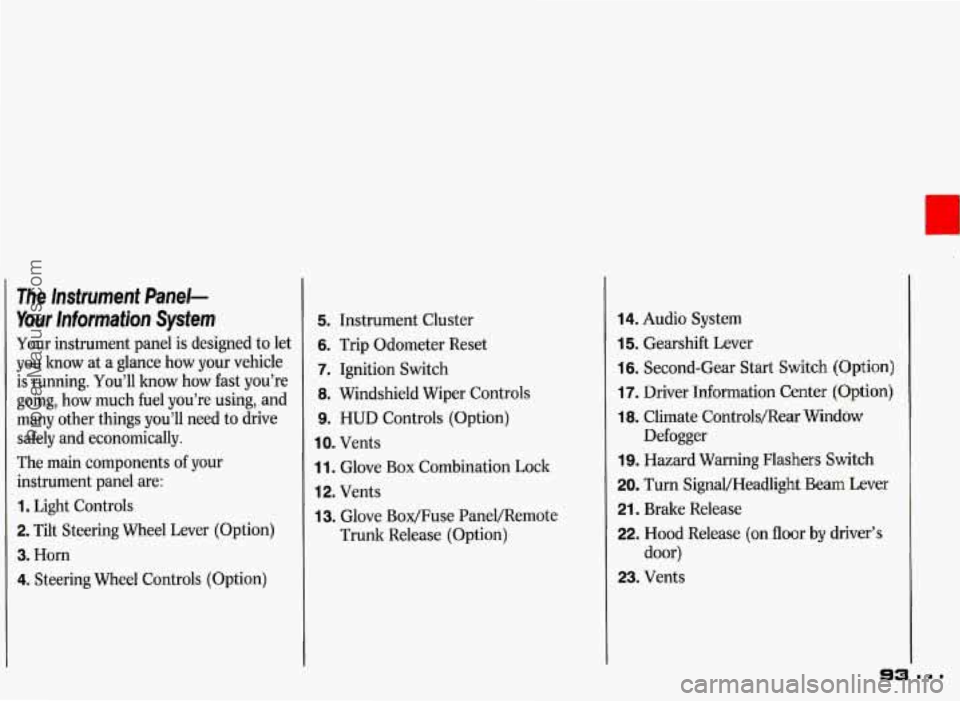
The Instrument Panel-
Your Information System
Your instrument panel is designed to let
you know at
a glance how your vehicle
is running. You’ll how how fast you’re
going, how much fuel you’re using, and
many other things you’ll need to drive
safely and economically.
The main components of your
instrument panel are:
1. Light Controls
2. Tilt Steering Wheel Lever (Option)
3. Horn
4. Steering Wheel Controls (Option)
5. Instrument Cluster
6. Trip Odometer Reset
7. Ignition Switch
8. Windshield Wiper Controls
9. HUD Controls (Option)
IO. Vents
1 1. Glove Box Combination Lock
12. Vents
13. Glove Box/Fuse PaneVRemote
Trunk Release (Option)
14. Audio System
15. Gearshift Lever
16. Second-Gear Start Switch (Option)
17. Driver Information Center (Option)
18. Climate Controls/Rear Window
19. Hazard Warning Flashers Switch
20. Turn SignaVHeadlight Beam Lever
21. Brake Release
22. Hood Release (on floor by driver’s
door)
23. Vents Defogger
ProCarManuals.com
Page 116 of 338
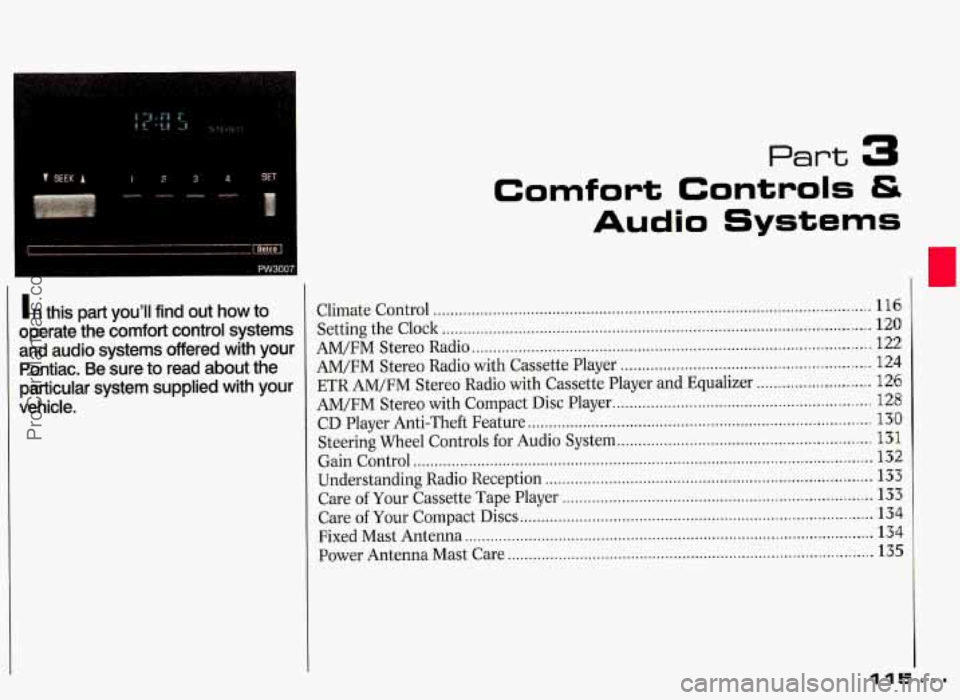
Part 3
Comfort Controls &
Audio Systems
1 n this part you'll find out how to
operate the comfort control systems
and audio systems offered with your Pontiac
. Be sure to read about the
particular system supplied with your
vehicle
.
Climate Control ........................................................................\
............................... 116
Setting the Clock ........................................................................\
............................. 120
AM/FM Stereo Radio ........................................................................\
...................... 122
AM/FM Stereo Radio with Cassette Player ........................................................... 124
ETR AM/FM Stereo Radio with Cassette Player and Equalizer ........................... 126
AM/FM Stereo with Compact Disc Player ............................................................. 128
Steering Wheel Controls for Audio System ............................................................ 131
Understanding Radio Reception ........................................................................\
..... 133
Care of Your Cassette Tape Player ........................................................................\
. 133
Fixed Mast Antenna 134
Power Antenna Mast Care 135
CD Player Anti-Theft
Feature
........................................................................\
......... 130
Gain Control ........................................................................\
.................................... 132
Care of Your Compact Discs ........................................................................\
........... 134
........................................................................\
........................
........................................................................\
..............
115
ProCarManuals.com
Page 117 of 338
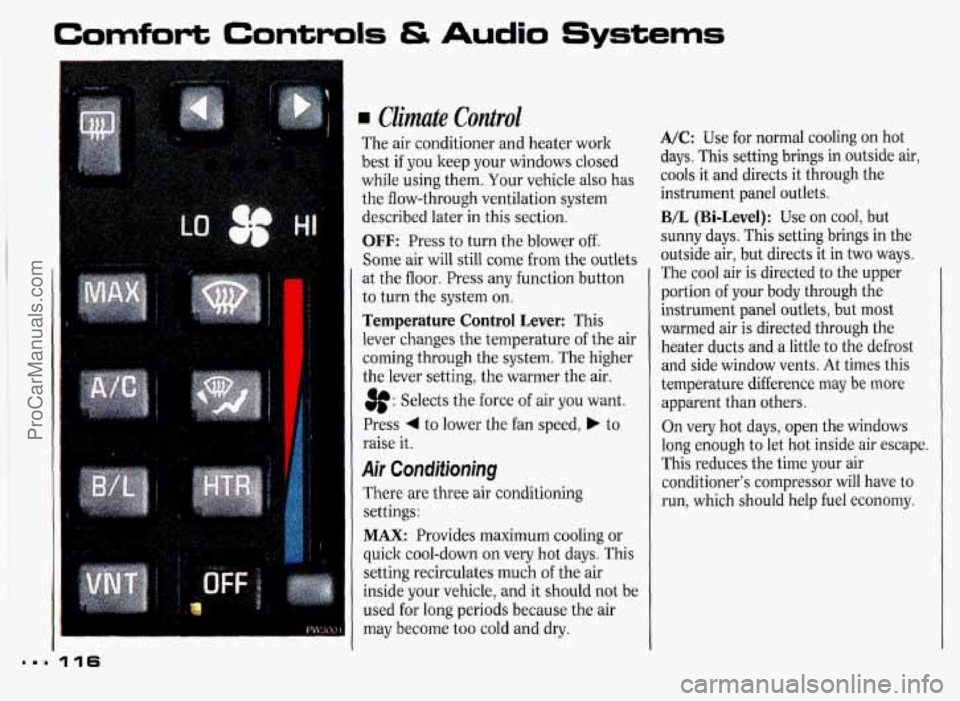
Comfort Controls & Audio Systems
Climate Control
The air conditioner and heater work
best
if you keep your windows closed
while using them. Your vehicle also has
the flow-through ventilation system
described later in this section.
OFF: Press to turn the blower off.
Some air will still come from the outlets
at the floor. Press any function button
to turn the system on.
Temperature Control Lever: This
lever changes the temperature of the air
coming through the system. The higher
the lever setting, the warmer the air.
a: Selects the force of air you want.
Press
4 to lower the fan speed, b to
raise it.
Air Conditioning
There are three air conditioning
settings:
MAX: Provides maximum cooling or
quick cool-down on very hot days. This
setting recirculates much
of the air
inside your vehicle, and it should not be
used for long periods because the air
may become too cold and dry.
A/C: Use for normal cooling on hot
days. This setting brings in outside air,
cools it and directs it through the
instrument panel outlets.
B/L (Bi-Level): Use on cool, but
sunny days. This setting brings in the
outside air, but directs it in two ways.
The cool air
is directed to the upper
portion
of your body through the
instrument panel outlets, but most
warmed air is directed through the
heater ducts and
a little to the defrost
and side window vents. At times this
temperature difference may be more
apparent than others.
On very hot days, open the windows
long enough to let hot inside air escape.
This reduces the time your air
conditioner’s compressor will have to
run, which should help fuel economy.
ProCarManuals.com
Page 259 of 338
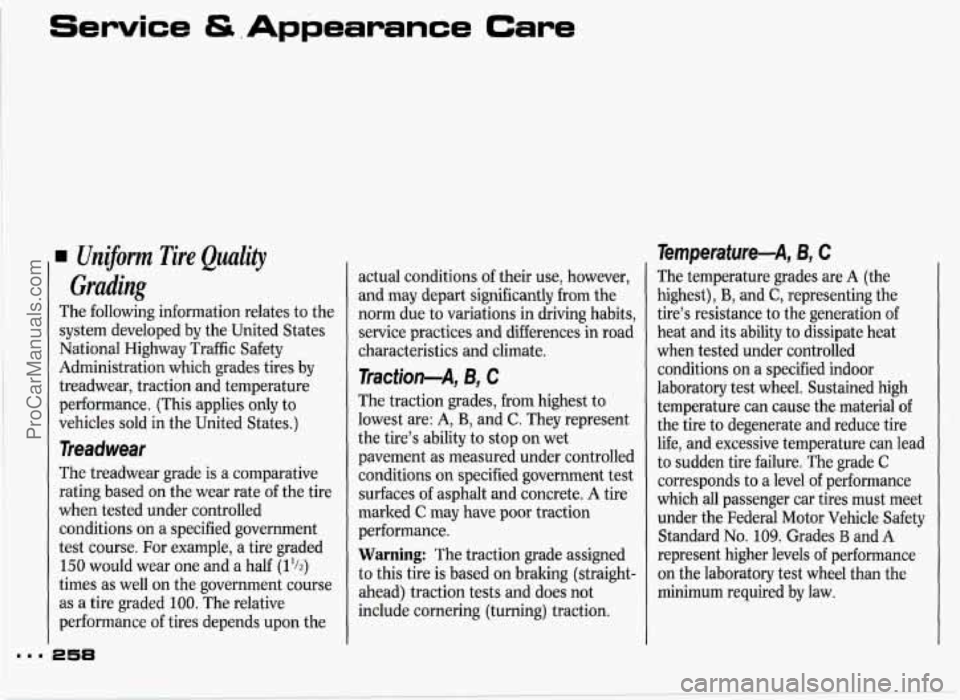
Service &.Appearance Care
Grading
The following information relates to the
system developed by the United States
National Highway Traffic Safety
Administration which grades tires by
treadwear, traction and temperature
performance. (This applies only to
vehicles sold in the United States.)
Treadwear
The treadwear grade is a comparative
rating based on the wear rate of the tire
when tested under controlled
conditions
on a specified government
test course. For example, a tire graded
150 would wear one and a half (1%)
times as well on the government course
as a tire graded
100. The relative
performance
of tires depends upon the actual conditions
of their use, however,
and may depart significantly from the
norm due to variations in driving habits,
service practices and differences in road
characteristics and climate.
Traction-A, B, C
The traction grades, from highest to
lowest are:
A, B, and C. They represent
the tire’s ability to stop on
wet
pavement as measured under controlled
conditions
on specified government test
surfaces of asphalt and concrete.
A tire
marked
C may have poor traction
performance.
Warning: The traction grade assigned
to this tire is based on braking (straight-
ahead) traction tests and does not
include cornering (turning) traction.
Temperature-A, B, C
The temperature grades are A (the
highest),
€3, and C, representing the
tire’s resistance to the generation of
heat and its ability to dissipate heat
when tested under controlled
conditions on a specified indoor
laboratory test wheel. Sustained high
temperature can cause the material of
the tire to degenerate and reduce tire
life, and excessive temperature can lead
to sudden tire failure. The grade
C
corresponds to a level of performance
which all passenger car tires must meet
under the Federal Motor Vehicle Safety
Standard
No. 109. Grades B and A
represent higher levels of performance
on the laboratory test wheel than the
minimum required by law.
ProCarManuals.com
Page 328 of 338
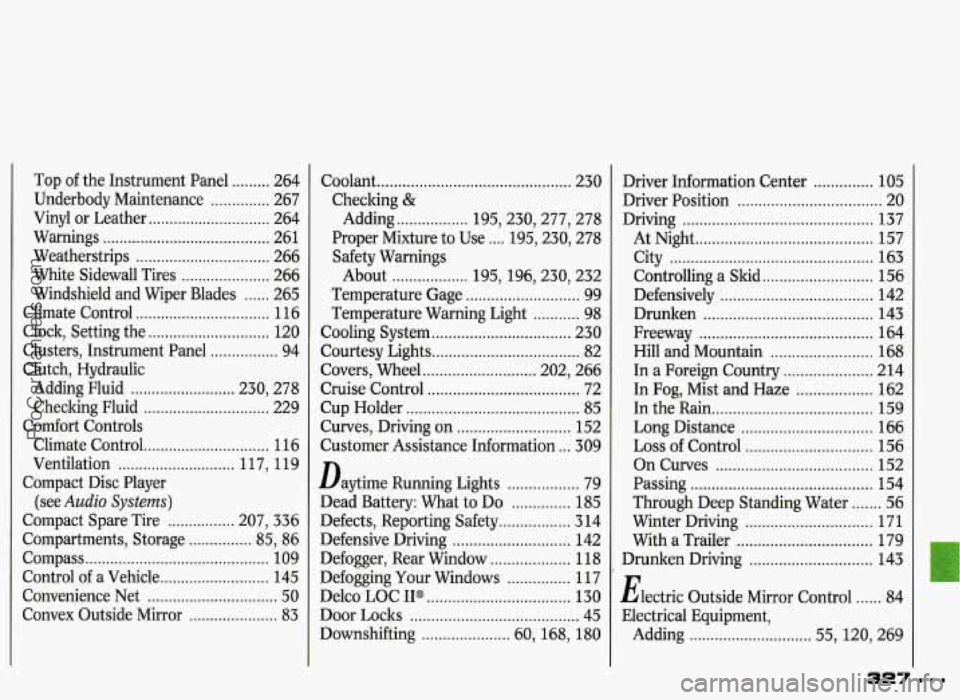
Top of the Instrument Panel ......... 264
Underbody Maintenance
.............. 267
Vinyl or Leather
............................. 264
Warnings
........................................ 261
Weatherstrips
................................ 266
White Sidewall Tires
..................... 266
Windshield and Wiper Blades
...... 265
Climate Control
................................ 116
Clock. Setting the
............................. 120
Clusters. Instrument Panel
................ 94
Clutch. Hydraulic Adding Fluid
......................... 230. 278
Checking Fluid
.............................. 229
Climate Control
.............................. 116
Ventilation ............................ 117. 119
Compact Disc Player (see
Audio Systems)
Compact Spare Tire ................ 207. 336
Compartments. Storage
............... 85. 86
Compass ............................................ 109
Control of a Vehicle
.......................... 145
Convenience Net
............................... 50
Convex Outside Mirror ..................... 83
Comfort Controls Coolant
.............................................. 230
Checking
&
Adding ................. 195. 230. 277. 278
Proper Mixture to Use
.... 195.230. 278
Safety Warnings About
.................. 195. 196. 230. 232
Temperature Gage
........................... 99
Temperature Warning Light
........... 98
Cooling System ................................. 230
Courtesy Lights
................................... 82
Covers. Wheel ........................... 202. 266
Cruise Control
.................................... 72
Cup Holder
......................................... 85
Curves. Driving on ........................... 152
Customer Assistance Information
... 309
Daytime Running Lights
................. 79
Dead Battery: What to Do
.............. 185
Defects. Reporting Safety ................. 314
Defensive Driving
............................ 142
Defogger. Rear Window
................... 118
Defogging Your Windows ............... 117
Delco LOC II@
.................................. 130
Door Locks
........................................ 45
Downshifting
..................... 60. 168. 180
Driver Information Center .............. 105
Driver Position
.................................. 20
Driving ............................................. 137
At Night
.......................................... 157
City
................................................ 163
Controlling a Skid .......................... 156
Defensively .................................... 142
Drunken
........................................ 143
Freeway
......................................... 164
Hill and Mountain ........................ 168
In a Foreign Country ..................... 214
In Fog. Mist and Haze
.................. 162
In the Rain
...................................... 159
Long Distance
............................... 166
Loss of Control .............................. 156
On Curves
..................................... 152
Passing
........................................... 154
Through Deep Standing Water
....... 56
Winter Driving .............................. 171
With a Trailer
................................ 179
Drunken Driving
............................. 143
Electric Outside Mirror Control
...... 84
Electrical Equipment.
Adding
............................. 55. 120. 269
ProCarManuals.com